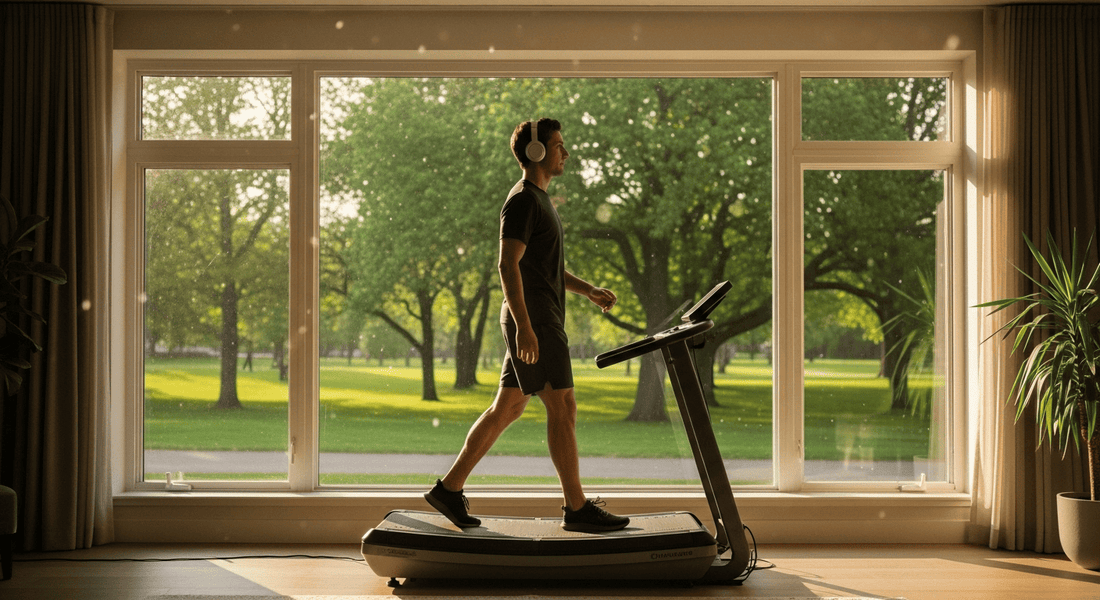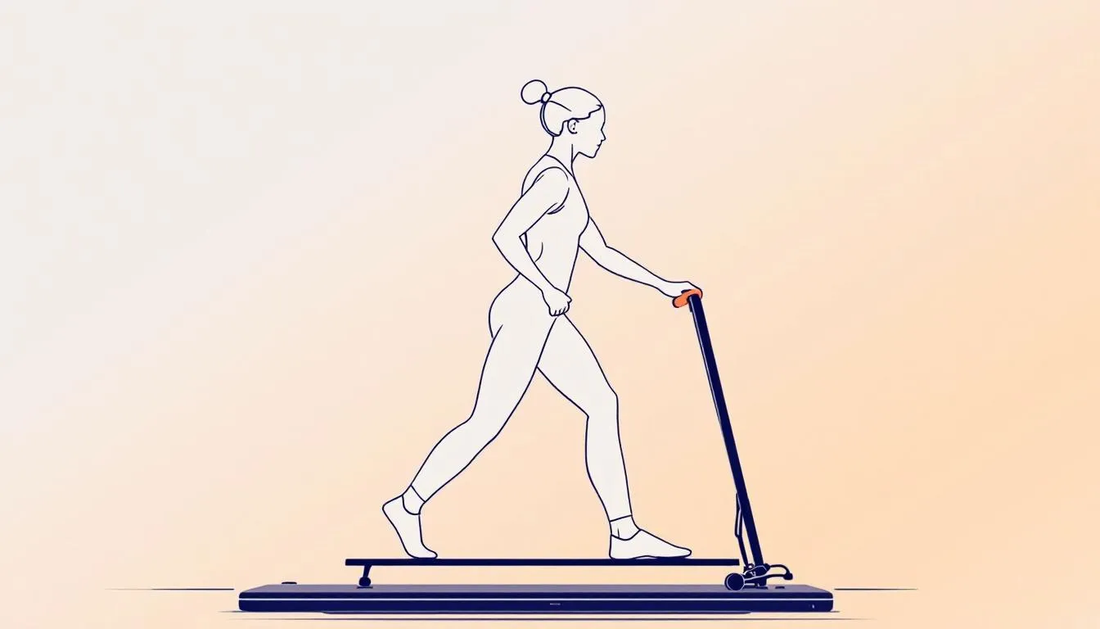Incline Treadmill Walking: A Complete Guide
Key Highlights
- Walking on an inclined treadmill is a great low-impact exercise. It raises your heart rate and helps you burn more calories than walking on a flat surface.
- This type of exercise targets different muscle groups in your lower body, like your glutes, hamstrings, and calves.
- You can adjust the incline and speed on the treadmill based on your fitness level and goals. This makes it a good choice for both beginners and experienced athletes.
- Be sure to keep proper form to get good results and avoid the risk of injury. Remember to warm up before you start and cool down afterward.
- Adding incline treadmill walking to your fitness routine can improve your cardiovascular health, help with weight loss, and boost muscle strength and endurance.
Introduction
Using an incline treadmill in your workout can greatly boost your fitness and heart health. This easy guide will give you important information about walking on an incline treadmill. It will explain the science behind it and give you helpful tips to begin. Whether you want to lose some weight, build your lower body, or just raise your heart rate, walking on an incline treadmill is a flexible and effective way to reach your fitness goals.
Understanding Incline Treadmill Walking
Imagine walking up a hill. That’s what incline treadmill walking does. By changing the incline of the treadmill, you create a climb. This makes your muscles work harder than when you walk on flat ground. The steeper the incline, the more difficult it gets and the more calories you burn.
Don't worry! Incline treadmill walking is good for everyone. You can change the incline and speed to fit your current fitness level. As you get stronger, you can increase the challenge.
This workout is great for people who find running hard on their joints. Incline treadmill walking gives you an excellent heart workout while being easier on your joints.
The Science Behind Incline Walking
Incline walking is very effective for several reasons. It comes down to how our body works. When you walk on an incline, your body has to push harder against gravity. This makes your heart rate go up more than when you walk on a flat surface. A higher heart rate helps you burn more calories and gives your heart better fitness.
Walking on an incline also uses more energy. This means that even if you cover the same distance as flat ground, your body uses more energy. This extra energy use can help with weight loss and better body shape.
Additionally, incline walking makes you use different muscles compared to walking on a flat surface. Although both ways work your leg muscles, incline walking focuses more on your glutes, hamstrings, and calves. This helps build more strength and power in your lower body.
Comparing Flat and Incline Treadmill Walking
While both flat and incline treadmill walking offer cardiovascular benefits, the difference in muscle activity and caloric expenditure sets them apart.
Walking on a flat surface primarily engages the quadriceps, with moderate activation of the hamstrings and minimal involvement of the glutes. Conversely, increasing the treadmill incline shifts the emphasis towards the glutes and hamstrings, making it a more effective workout for targeting these muscle groups.
Here's a simple table highlighting the key differences:
|
Feature |
Flat Treadmill Walking |
Incline Treadmill Walking |
|
Muscle Focus |
Primarily Quadriceps |
Glutes, Hamstrings, Calves |
|
Calorie Burn |
Moderate |
Higher |
|
Intensity |
Lower |
Higher |
Benefits of Incline Walking on a Treadmill
Incline treadmill walking is not just a trend; it has many benefits for your health and well-being. It can help improve your heart health and shape your lower body. There is scientific evidence supporting these advantages.
As you continue reading, you will see why this flexible workout is a great addition to your fitness routine. It is good for everyone, no matter your fitness level or experience.
Boosting Cardiovascular Health
Engaging in regular exercise is important for a healthy heart. Aerobic activities, like incline treadmill walking, are especially beneficial. The American Heart Association says to aim for at least 150 minutes of moderate exercise each week, like brisk walking. This helps improve cardiovascular health and lowers the chances of heart disease.
When you walk on an incline, your heart works harder. This makes your heart muscle stronger and helps it pump blood better throughout your body. As your heart becomes more efficient, your resting heart rate goes down, and your blood pressure lowers. These changes show that your cardiovascular system is healthy.
Walking on an incline also helps your cholesterol. It raises good cholesterol (HDL) and lowers bad cholesterol (LDL). This improvement in cholesterol levels helps reduce the risk of heart disease, stroke, and other heart-related issues.
Accelerating Weight Loss Efforts
If losing weight is one of your fitness goals, walking on an incline treadmill can really help you. This type of aerobic exercise burns more calories, which is important for creating the calorie deficit needed to lose weight.
When you walk on an incline, you increase your heart rate and use more muscles. This helps your body burn more calories while you work out and even after you finish. This effect is called EPOC, or Excess Post-Exercise Oxygen Consumption. It keeps your metabolism working faster even after you are done exercising, helping you lose weight.
But exercise alone isn't enough. To keep losing weight, you should mix incline treadmill walking with a balanced diet and a healthy lifestyle. Remember, being consistent is important. Try to make walking on an incline a regular part of your routine for long-term benefits.
Enhancing Muscle Strength and Endurance
Walking on an incline treadmill helps you target specific muscle groups easily. The incline really benefits your lower body by strengthening your leg muscles, core, and back. As you walk uphill, your glutes, hamstrings, and calves get a great workout. This leads to stronger muscles and better endurance.
Stronger leg muscles not only make walking and running better but also improve your balance and stability. This helps reduce the chance of falls and injuries. Additionally, having more muscle can boost your metabolism, making it easier to keep a healthy weight over time.
Adding incline treadmill walking to your fitness routine builds stronger and more defined leg muscles. It also strengthens your core, which helps improve your overall fitness and makes daily activities easier.
Setting Up Your Treadmill for Incline Walking
Now that you know the great benefits of incline treadmill walking, let's talk about how to get ready for a safe and good workout. The first step is to set up your treadmill the right way. This will help you make the most of your effort and lower the risk of injury.
You need to consider a few things, like picking the right incline level and changing the speed.
Choosing the Right Incline Level
The great thing about walking on an incline treadmill is how easy it is to change the incline. You can set it according to your fitness level and goals. If you are new to this, start with a lower incline, around 3-5 percent. You can increase the incline slowly as you get fitter.
It’s important to push yourself but not to overdo it. A steep incline might be too much for beginners and could lead to the risk of injury. Remember, it’s not about tackling the highest incline but about challenging yourself regularly.
Once you adapt to incline walking, try out different incline levels. This keeps your workouts fun and makes your muscles work harder. Changing your incline during your workout can help avoid boredom and stop you from reaching a plateau.
Adjusting Speed for Optimal Results
Adjusting the speed on your treadmill is important when you also set the incline. The right speed depends on your workout routine, what you can do aerobically, and your fitness goals. For most people, a fast walking pace is a good place to start.
If you struggle to breathe within the first few minutes, try slowing down. You can gradually go faster as you get stronger. If your workout feels too easy, speed it up or raise the incline. Combining both can give you an extra challenge.
It's important to be consistent and make slow changes to have a safe and effective workout on an incline treadmill. Pay attention to your body and change the speed and incline as needed. Aim to keep a hard but steady pace during your workout.
Incline Walking Techniques for Beginners to Advanced
Incline treadmill walking is great for everyone, whether you are just starting or are an experienced athlete. It has methods and challenges that fit all skill levels. By learning how to progress and mix things up, you can keep pushing yourself and getting better results.
We will look at incline walking methods, from using a low incline for beginners to adding interval training for more advanced fitness.
Starting with Low Incline and Gradually Increasing
For beginners, it is important to start with a low incline. This helps your body get used to the exercise and avoids injury. Start with an incline of about 1-3 percent and slowly increase it. Focus on keeping good form and walking at a quick pace. As your overall fitness improves, you can raise the incline.
Remember, this is not a race. Gradually increasing the incline is better for you in the long run. Listen to your body and change the incline if you need to. If you feel pain or discomfort, take a break before you continue.
Being consistent is key when you add incline treadmill walking to your routine. Even small increases in incline each week will add up. This can lead to big improvements in your fitness level over time.
Incorporating Interval Training on an Incline
Once you have a strong base from incline treadmill walking, think about adding interval training to your routine. It can help make your workouts more challenging and increase your calorie burn and cardiovascular endurance. Interval training means switching between times of hard exercise and times of rest or easy exercise.
A simple way to do this on an incline is to alternate between walking at a moderate incline for a set time, then doing a quick burst at a steeper incline. For example, walk at a 3 percent incline for 3 minutes, then go for 1 minute at a 6 percent incline. Keep repeating this pattern for how long you want to exercise.
Interval training raises your heart rate and burns many calories. It also helps improve your aerobic capacity and endurance, making your body better at using oxygen.
Avoiding Common Mistakes in Incline Treadmill Walking
Incline treadmill walking has some common mistakes that can slow your progress or cause injury. If you know these mistakes and avoid them, you can have a safe and effective workout each time you use the treadmill.
Common problems include not paying attention to your posture and forgetting to warm up or cool down. Let's look at these mistakes and how you can avoid them when you walk on an incline treadmill.
Overlooking Posture and Form
Maintain good posture and form while using an incline treadmill. This will help reduce the risk of injury, especially to your low back and hips. If you lean forward or hunch your shoulders, it can strain your neck, shoulders, and low back. This can take away the workout's benefits.
Stand up straight with relaxed shoulders and an active core. Look straight ahead. Avoid glancing down at your feet or up at the console. Allow your arms to swing naturally. This will help you keep your balance and rhythm.
Also, try not to hold onto the treadmill rails for support. Even though it might seem useful, it can make your workout less effective and lead to poor form. If you need to hang on for balance, consider lowering the incline or speed. This way, you can build your strength and stability to walk without holding on.
Ignoring the Importance of Warm-up and Cool-down
Skipping your warm-up or cool-down is a common mistake. It can raise your risk of injury and slow down muscle recovery. Warming up the right way gets your body ready for the workout. It increases blood flow to your muscles and raises your heart rate. You can do this by walking on a flat incline for a few minutes. Then, do some dynamic stretches that focus on your lower body. This will help prepare your muscles for the incline workout.
Cooling down after your workout is also very important. It helps your heart rate and breathing go back to normal. This process can lessen muscle soreness by getting rid of lactic acid in your body. A light walk to cool down, followed by static stretches, helps your muscles recover well and get used to the workout.
Make sure to add a good warm-up and cool-down to your incline treadmill walking routine. Doing this is key for getting the best results and lowering the risk of injury.
Conclusion
In conclusion, walking on an incline treadmill has many benefits. It helps your heart health, aids in weight loss, and builds muscle strength. To get the most from your workouts, understand the science behind it and use the right techniques. Always focus on maintaining good form. Make sure to warm up and cool down to prevent mistakes. No matter if you are a beginner or advanced, adjust the incline level and speed to match your fitness level. So, put on your shoes, set the incline, and step towards a healthier, stronger you.
Frequently Asked Questions
How Often Should I Incorporate Incline Walking into My Routine?
It's a good idea to add incline walking to your workouts regularly, about 2-3 times a week. The right amount for you will depend on your fitness level and the rest of your workout routine. Make sure to include rest days. This gives your muscles time to heal and grow stronger. This will help improve your cardiovascular health and support your fitness journey.
Can Incline Walking Replace Outdoor Hill Workouts?
Walking on an incline treadmill uses similar muscles and gives heart benefits like walking up a hill outdoors. But, it can't completely match the hard work of climbing a steep hill. Still, a treadmill incline is a good option, especially when the weather is bad or you can't easily go outside.
What is the Ideal Incline Setting for Weight Loss?
There isn't a single perfect incline for weight loss. It really depends on your fitness level and your specific goals. Usually, a higher percent incline helps you burn more calories and increases metabolic cost. Start at a comfortable incline, and then raise it slowly as you improve. Always pay attention to how your body feels during this process.




